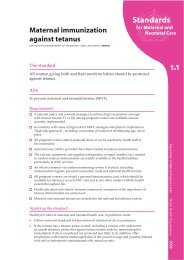1uvZ4zN
1uvZ4zN
1uvZ4zN
You also want an ePaper? Increase the reach of your titles
YUMPU automatically turns print PDFs into web optimized ePapers that Google loves.
Volume III<br />
Chapter ONE<br />
Land<br />
69. Land is a key factor in understanding ethnic tension and violence in Kenya. When<br />
the white settlers came to Kenya, they found some parts of the country unsuitable<br />
for their settlement, “either because of the climate or because it was infested by<br />
tsetse fly.” 56 However, the land between the Gikuyu escarpment and Lake Victoria<br />
was deemed potentially rich for agro-based development. Owing to its favourable<br />
climate and fertile soils and given that the Uganda Railway traversed the region,<br />
white settlers were determined to turn it into a “white man’s country”. 57 Thus, from<br />
the early-1900s, there was an influx of settlers from Britain and South Africa. 58 At the<br />
same time the colonial government began to impose restrictions access to land by<br />
the existing Kenyan residents. The NCIC recently summarized this restrictive and<br />
discriminatory history:<br />
During the colonial era, there was extensive land expropriation and resettlement by<br />
the colonialists from the indigenous communities. Land expropriation was extensive,<br />
from 2 million hectares in 1914 to 3 million hectares on the eve of independence.<br />
The expropriation was achieved through various laws, ordinances and promulgations,<br />
including the Native Trust Bill of 1926 which restricted indigenous groups to the Native<br />
Reserves. These realities raised the profile of land ownership and required extensive<br />
attention into independence to reduce their adverse impact on national cohesion and<br />
integration in Kenya. Land-related issues continue to be a lingering source of conflict<br />
to date. 59<br />
70. The European invasion of the White Highlands, as the region later came to be<br />
known, became the source of economic marginalization in the country. In the<br />
main, European occupation of the region meant displacement of Africans from<br />
their traditional homeland. 60<br />
71. Kenyans displaced from their land by the colonial government were concentrated<br />
in reserves, something that considerably restricted their socio-economic life. 61<br />
Those who did not prefer to live in the reserves remained in European farms either<br />
as squatters or as labourers, or sought employment in urban areas. 62<br />
72. The Mau Mau rebellion to colonial rule had a profound impact on the country since<br />
it forced the colonial government to rethink and reformulate its discriminatory<br />
56 R Morrock ‘Heritage of strife: The effects of colonialist ‘divide and rule’ strategy upon the colonized peoples’ Science and Society<br />
(1973) 135.<br />
57 K Shillington History of Africa (1995) 339.<br />
58 As above.<br />
59 National Cohesion and Integration Commission (n 100 above) 9.<br />
60 DA Percox Britain, Kenya and the cold war: Imperial defence, colonial security and decolonisation (2004) 15.<br />
61 DA Percox Britain, Kenya and the cold war: Imperial defence, colonial security and decolonisation (2004) 15.<br />
62 As above.<br />
REPORT OF THE TRUTH, JUSTICE AND RECONCILIATION COMMISSION<br />
25






